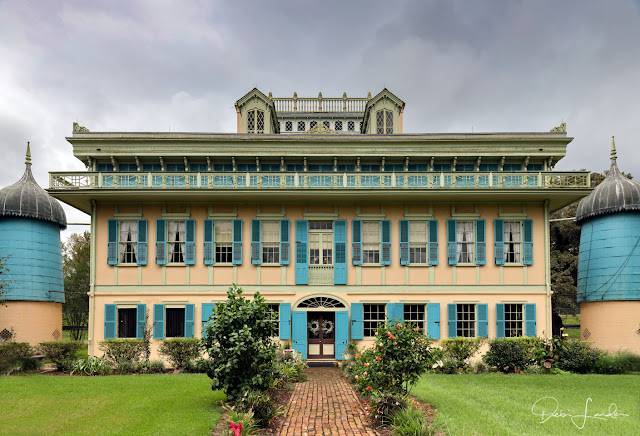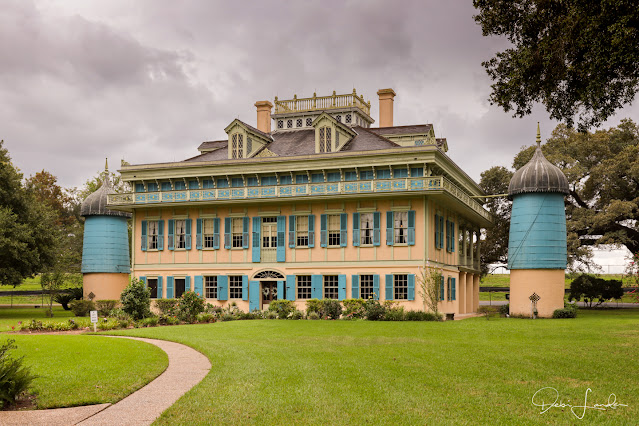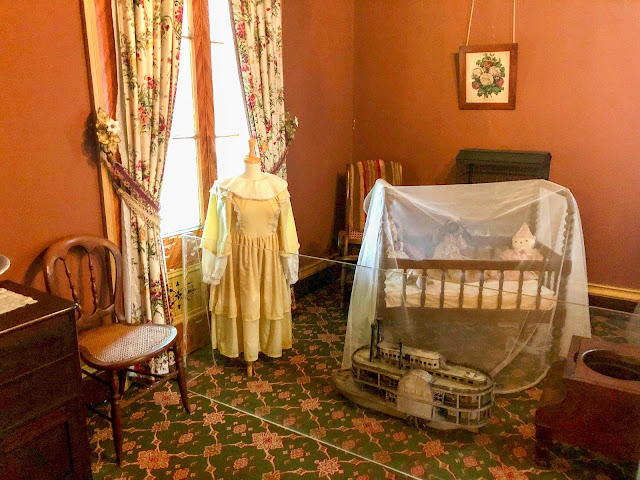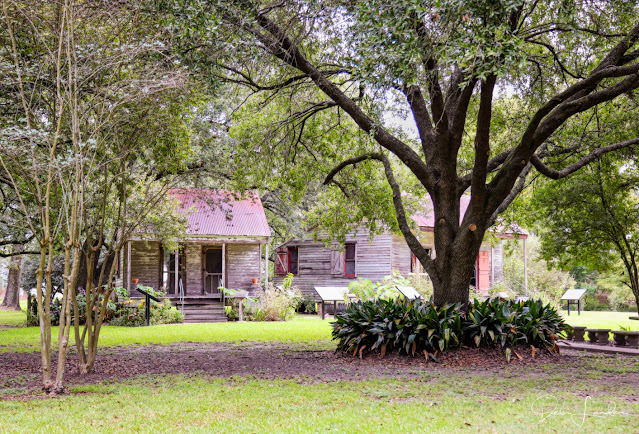The Good Girls multi-stop road trip down the Natchez Trace Parkway ended in Natchez, MS. Since plans called for returning the rental car in New Orleans, Judy and Debi decided to extend their trip and visit the River Parishes of Louisiana, including a swamp tour, some Cajun kitchens, and a few plantations.
 |
| There's beauty in the Louisiana bayou. |
Debi reports: We drove south to Garyville, Louisiana, to visit San Francisco Plantation located on the east bank of the Mississippi River. For those coming from New Orleans, it's about a 45-minute drive west of the city. You might be shocked by the curbside location as the San Francisco Big House stands sandwiched between the current road and levee-- and without a river view. Neither the road nor embankment existed during original construction.
 |
| An aerial views hows the closeness of the road to the house. |
Previously, I had seen San Francisco from a distance, and the extraordinarily colorful house intrigued me. Now, I relished the chance to explore the grounds and interior. Judy and I arrived just in time to capture a quick photo and enter the big house as the clouds burst open.
 |
| Clouds about to burst over San Francisco Plantation. |
Some folks think the architectural structure looks like a riverboat; in fact, it inspired a novel called "Steamboat Gothic." In my opinion, the house reminded me of Laura Plantation, another nearby, brightly painted Creole-style home; however, Laura is much smaller. San Francisco claims to contain one of the finest antique collections in the country, although none of the furnishings are original to the owners. Sadly, a later purchaser removed the house furniture and inventory, and they perished in a fire.
The History
We shook off the rain and met our costumed guide in a big hoop skirt at the entrance, actually what was formerly the back door. She began with a brief but tangled history of the property, the house, and the owners. Her narrative brought these characters to life, so much so that I could envision them sitting in the parlor, or the children playing games.
 |
| Our tour guide |
To summarize, Elisée Rillieux, a free man of color and a smart visionary, purchased the land in 1827. A speculator, he wanted to establish a sugar plantation but never intended to be a planter himself. Three years later, Elisée sold the estate to Edmond Bozonier Marmillion and his partner Eugène Lartigue for the enormous sum of 100,000 dollars, collecting an estimated $50,000 profit.
According to brochures, Edmond, in debt from day one, immediately began sugar production. Although he became a successful planter of large crops… and continued to acquire slaves and purchase additional swampland, he invested little in modern sugar machinery. However, during the prosperous 1850s, the plantation became a huge economic success.
 |
| Old Photo shows the former front gardens at San Francisco Plantation. |
Edmond's wife died of tuberculosis in 1843, and over the next twenty years, so did six of his eight children. By 1853, Edmond began to build the mansion that exists today for his two surviving sons, Valsin and Charles. He hired expert builders and purchased twelve highly skilled slaves to convert his extravagant dream into reality. Two years later, Edmond found accomplished artists to carry out an ambitious decoration projectfeaturing intricate hand-painted ceilings, painted door panels, faux marbling, and faux wood graining.
 |
| Photo of Edmond Marmillion on display at San Francisco Plantation. |
Edmond died in 1856, less than one year after construction was complete. The day after Edmond's death, his oldest son Valsin returned from Europe. Instead of arriving at a party, he and his wife Louise heard the sad news. They had no choice but to take over the plantation's management. Valsin, Louise, and their three daughters stayed on and ran the sugar plantation for the next fifteen years. The décor you see on tour is from that antebellum period.
The unusual name "San Francisco" is believed to be derived from Valsin's comment about the astronomical debt he discovered when taking over the estate. He declared he was sans fruscins or "without a penny in my pocket." The name evolved into St. Frusquin, and in 1879, the next owner changed it to "San Francisco." The plantation has no connection to the California city.
The Tour
 |
| Arrival at San Francisco Plantation. Note the cisterns. |
Our tour began in the food storage room, then the wine cellar, and china pantry. As customary at the time, the kitchen was in an outbuilding. The guide explained that the two cisterns (topped with Moorish domes) on either side of the house collect rainwater used for drinking and washing.
 |
| China Closet |
We passed through the billiard room where the men enjoyed the game and moved into the lovely dining room set for a formal dinner. The frescoed ceiling is just a small sample or the extensive artistic work in the upstairs bedrooms.
 |
| Formal Dining Room table is set for a meal at San Francisco Plantation. |
Moving upstairs, we found a large, airy central reception area that ran across the front of the house. The bedrooms feature intricately painted ceilings, heavily carved wood furniture, and beds draped with mosquito netting, surely a necessity in those times. Even some cabinets and wall shades display hand-painted accents.
 |
| Valsin, the plantation owner's bedroom. |
 |
| Charles' bedroom, brother of the owner. |
Highlights in the children's bedroom include zebra-wood graining, a cradle, and antique toys.
 |
| Children's Bedroom and antique toy riverboat. |
I'd consider the rear loggia, or former front porch, the equivalent of today's family room. A grand double-sided staircase runs across and down this facade of the house. A black-and-white photograph helped me imagine the magnificent panoramic view of the gardens and the Mississippi River before the high levee construction.
 |
| Former Formal Gardens at the Big House. |
As we went through the rooms, our guide pointed out the various antique items and the period furniture and shared more stories about the families living there.
 |
| Family Photos on display, |
The restoration of this mansion became a massive project undertaken with the financing of the oil refinery money. While the unappealing pipes and buildings of the refinery remain nearby, the profits saved this site now considered a National Historic Landmark. I am pleased our guide acknowledged and praised the work of the enslaved on the property. She spoke about their labor and personal life, plantation routines, and rituals. Their original expert construction made the mansion salvageable and worth restoring. We learned the lead carpenter had the highest worth of any slave on the property before the Civil War, valued at $2,000.
 |
| An old black and white photo of San Francisco Plantation House before restoration. |
 |
| Rooms have intricately painted ceilings at San Francisco Plantation. |
Judy and I planned to visit the original 1840 slave cabin, mainly to see the child-sized sculptures by the famous artist Woodrow Nash. (Read my story on his works at Whitney Plantation here.) However, the rain did not let up, and we did not have umbrellas.
 |
| The Slave Cabin and School House. |
We also missed the schoolhouse dating back to the 1830s. The pictures and texts exhibited at these buildings serve as an introduction to the extensive research on the legacy of San Francisco Plantation.
 |
| Woodrow Nash Sculpture |
Adding to the research are over 100 letters Louise wrote to her family in Germany. They were kept and translated, providing historians with accurate information about her Louisiana lifestyle. Seems that by 1859, Valsin and hisyounger brother Charles attempted to sell the estate, but a legal conflict halted their plans. When settled in 1861, it was too late. War and reconstruction prevented the sale for the next fifteen years. Valsin died of tuberculosis in 1871. Charles, who had served in the Confederate Army for four years, helped Louise sustain the estate until he passed away in 1875. Four years later, Louise finally sold the plantation for a mere $50,000, never coming close to maintaining the profitable crops they had before the Civil War. She returned to Germany.
 |
| Louise |
For those interested in what happened to the home after Louise, here's what I found online.
After the Great Flood in 1927, the Army Corps of Engineers began building the Mississippi River levee system, completed in 1932. The new levee, unfortunately, sacrificed the gracious front yard and gardens. The project would have also claimed the home, but residents lobbied the Louisiana legislature to save as many plantations as possible along the River Road. Fortunately, the Corps was able to curve the levee around San Francisco.
In 1954, Mr. and Mrs. Clark Thompson leased the property and opened the mansion to the public. Thankfully, the Thompsons did not make structural changes and preserved the home.
Finally, in 1974, Mrs. Thompson, then widowed, moved out. The ECOL Company, later Marathon Oil, purchased the property. They donated it and seven acres to the San Francisco Plantation Foundation. After scientific analysis of the structure and materials and archival research, the massive restoration began. After two years, the completed project opened for tours. The oil company continues to help defray the enormous cost of maintenance.
San Francisco Plantation is open for tours most days, but call ahead to verify. Allow for at least two hours when visiting this property.
www.SanFranciscoPlantation.org
2646 Hwy. 44 (River Road)
Saint John the Baptist Parish
Garyville, Louisiana 70051-0950






























